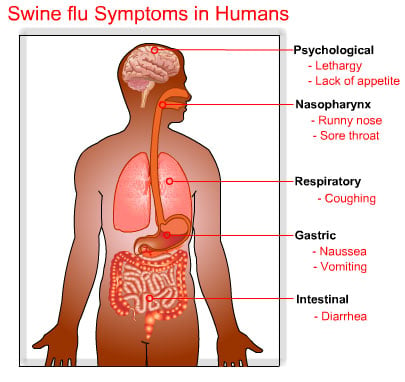Nursing Paper Example on Swine Influenza
Nursing Paper Example on Swine Influenza
Swine influenza, also known as swine flu, is a respiratory disease in pigs caused by type A influenza viruses. While primarily affecting swine, certain strains can infect humans, leading to outbreaks and, in some cases, pandemics.

Causes and Transmission
Causative Agent
Swine influenza is caused by influenza A viruses, primarily subtypes H1N1, H3N2, and H1N2. These viruses commonly circulate among pigs and occasionally jump species to infect humans. The 2009 H1N1 influenza pandemic was linked to a novel H1N1 virus with genetic elements from swine, avian, and human influenza viruses (World Health Organization [WHO], 2023).
Transmission to Humans
Swine influenza primarily spreads among pigs through respiratory droplets, contaminated surfaces, and direct contact. Transmission from pigs to humans can occur through close contact, particularly in settings like pig farms and livestock markets. Once in humans, the virus can spread from person to person through respiratory droplets when an infected person coughs or sneezes, similar to seasonal flu (Centers for Disease Control and Prevention [CDC], 2022).
Signs and Symptoms
The symptoms of swine influenza in humans are similar to those of seasonal flu and may include:
- Fever: Often the first noticeable symptom.
- Cough: Dry or productive, with sore throat.
- Body Aches: Muscle pain, fatigue, and general weakness.
- Headache: Often accompanied by chills and shivering.
- Respiratory Symptoms: Shortness of breath, particularly in severe cases.
- Gastrointestinal Symptoms: Some patients experience nausea, vomiting, and diarrhea.
These symptoms usually appear 1-4 days after exposure and range from mild to severe, depending on the individual’s overall health and immune response (CDC, 2022).
Diagnosis
Diagnosis of swine influenza involves clinical evaluation and laboratory testing. Key diagnostic methods include:
- Rapid Influenza Diagnostic Tests (RIDTs): Provide preliminary results by detecting viral antigens but have limited sensitivity.
- Reverse Transcriptase-Polymerase Chain Reaction (RT-PCR): The gold standard test for swine flu, providing highly accurate results by detecting viral RNA.
- Viral Culture: Involves growing the virus in a laboratory setting for detailed analysis, though it is more time-consuming.
- Serological Tests: Assess immune response by detecting antibodies, especially helpful for retrospective diagnosis (Matsumoto et al., 2021).
RT-PCR is the preferred diagnostic tool due to its accuracy, especially in detecting various influenza A subtypes, including those associated with swine influenza.
(Nursing Paper Example on Swine Influenza)
Treatment
Treatment for swine influenza primarily focuses on antiviral medications and supportive care:
- Antiviral Medications: Oseltamivir (Tamiflu) and zanamivir (Relenza) are the main antiviral drugs used to treat influenza, including swine influenza. Early administration, preferably within 48 hours of symptom onset, improves efficacy.
- Symptom Management: Rest, hydration, and over-the-counter pain relievers can help manage symptoms such as fever and body aches.
- Hospitalization: Severe cases may require hospitalization for respiratory support or additional medical care.
Antiviral resistance is a growing concern, so healthcare providers should prescribe antivirals based on current resistance patterns and guidelines (WHO, 2023).
Complications
In most cases, swine influenza is self-limiting, but certain populations are at higher risk for complications:
- Respiratory Complications: Viral pneumonia, acute respiratory distress syndrome, and secondary bacterial infections.
- Cardiovascular Complications: Myocarditis and pericarditis, particularly in elderly individuals and those with underlying heart disease.
- Neurological Complications: Rare cases of encephalitis, seizures, and other neurological symptoms, especially in children.
High-risk groups for complications include young children, elderly adults, pregnant individuals, and people with chronic health conditions like asthma, diabetes, or heart disease (CDC, 2022).
Prevention
Preventing swine influenza requires a combination of personal hygiene, vaccination, and public health interventions:
- Vaccination: Seasonal influenza vaccines protect against common human influenza strains, although they do not typically cover all swine flu variants. In high-risk settings, such as pig farms, vaccination of pigs may help reduce transmission.
- Personal Protective Measures: Handwashing, mask-wearing, and avoiding contact with infected pigs can reduce the risk of transmission.
- Public Health Monitoring: Surveillance of pig populations and human cases is essential to detect outbreaks early and mitigate spread.
- Isolation of Infected Individuals: Infected individuals should self-isolate to prevent further transmission, particularly in healthcare settings or densely populated areas (CDC, 2022).
Effective prevention requires coordination between public health agencies, healthcare providers, and agricultural sectors to monitor and control outbreaks in both swine and human populations.
Conclusion
Swine influenza is a zoonotic disease caused by influenza A viruses that can jump from pigs to humans, posing significant public health risks. While symptoms in humans are often similar to seasonal flu, the disease can lead to severe complications, especially in vulnerable populations. Diagnosis relies on clinical symptoms and laboratory testing, with RT-PCR as the most reliable method. Treatment involves antiviral drugs, supportive care, and symptom management. Prevention includes vaccination, personal hygiene, and surveillance. Public awareness and early intervention are essential for controlling swine influenza and preventing pandemics.
References
Centers for Disease Control and Prevention (CDC). (2022). Swine influenza: Causes, symptoms, and prevention. https://www.cdc.gov/flu/swineflu
Matsumoto, K., Oka, T., Suzuki, K., & Kinoshita, H. (2021). Influenza virus and public health implications: Diagnosis, treatment, and control. Japanese Journal of Infectious Diseases, 74(2), 112-123. https://www.jstage.jst.go.jp/article/yoken/74/2/74_112/_pdf
World Health Organization (WHO). (2023). Influenza at the human-animal interface: Zoonotic influenza viruses. https://www.who.int/news-room/fact-sheets


